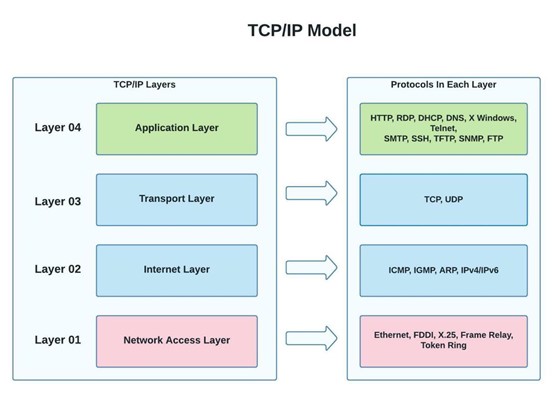TCP/IP Model Layers
TCP/IP Model comprises four layers, each of which has its own set of protocols and functions:
- Network Access Layer
- Internet Layer
- Transport Layer
- Application Layer
In this post, we will discuss TCP/IP Layers and their functions.
Network Access Layer
The Network Access Layer defines the mechanism of how data is physically transmitted via the network. It also includes how bits are optically or electrically communicated by hardware devices that directly interact with a network medium, such as twisted-pair copper wire, optical fiber, and coaxial cable. In TCP/IP model, Network Access Layer is the lowermost layer.
To deliver data and identify hosts, the physical address is utilized in the Network Access Layer. A “frame,” which is the Network Access layer PDU (Protocol Data Unit), contains the IP packet as a protocol header and trailer. Before transmitting a frame to the next destination of the physical network, a router removes the header and trailer and replaces them with new headers and trailers.
Functions of Network Access Layer
Here is the list of some primary functions that the Network Access Layer perform in the TCP/IP Model:
- The Network Access Layer defines the procedure of data transmission over a network.
- It is primarily in charge of the data transmission between two networked devices.
- This layer performs functions such as translating IP addresses to physical addresses and encapsulating IP datagrams into network frames.
Network Access Layer Protocols
FDDI, X.25, Ethernet, Frame Relay, Token Ring are included in the Network Access Layer.
Internet Layer
In the TCP/IP model, the Network layer or the Internet layer is the second layer. Data is packed into IP datagrams by the Internet layer, including source and destination address information for forwarding datagrams across networks and between hosts. This layer is present in between Transport and Network Access Layer.
Hosts can insert and deliver to a destination, either on the same or another remote network, using the Internet layer. When there exists an order difference in the data transmission and the received packets, then the task of the higher layers of the TCP/IP model is to restructure them so that they can be delivered to the network applications running at the Application layer.
Functions of the Internet layer
Here is the list of main functions of the Internet layer:
- One of the main functions of the Internet layer is to send data packets to their destination networks.
- It can handle forwarding, path determination, and logical addressing.
- IP datagram routing comes under the responsibilities of the Internet layer.
- Routing protocols are utilized at this layer to help routers learn about various networks they can access and deliver error messages.
Internet Layer Protocols
IP, RARP, ICMP, IGMP, and ARP are the primary protocols used at the Internet layer (Internet Group Management Protocol).
Transport Layer
The Transport layer is placed on the Network layer to offer data transmission from a source system process to a destination system process. The Transport layer can be hosted on single or multiple networks, and it also manages service quality functions. In the TCP/IP model, this third layer defines where, when, and how much data should be sent at a specific rate. The messages received from the Application layer are used by the transport layer. It also ensures that data united are transmitted in an error-free and timely manner.
The transport layer assists in regulating the reliability of a link by providing segmentation or de-segmentation, flow, and error control. If no error is encountered, the transport layer acknowledges the successful transmission of the data and sends the next data packet.
Functions of Transport Layer
The following are some of the essential functions of Transport Layers:
- The message is sent to the relevant process on the destination machine by the transport layer.
- It also ensures that the complete message arrives without error; otherwise, it must be re-transmitted from the source system.
- It separates and counts the messages received from the session layer into segments for creating a sequence.
Transport Layer Protocols
The Transport Layer employs TCP and UDP protocols.
Application Layer
At the top of the Transport layer, the Application Layer is present in the TCP/IP Model. The Application layer defines the procedure of interaction between the host applications and the protocols. In this interaction, the applications interact with the transport layer services for using the network. It also specifies the protocols going to be used by TCP/IP applications.
Functions of Application Layer
Now, let’s look at some other functions of the Application layer:
- The Application layer provides access to global information about numerous services and objects from distributed database sources.
- This layer plays its part in the identification of communication partners, communication synchronization, and resource availability.
- The application layer enables users to connect to a remote server.
- It also offers a variety of e-mail services.
Application Layer Protocols
Higher-level protocols such as HTTP, RDP, DHCP, DNS, X Windows, Telnet, SMTP, SSH, TFTP, SNMP (, FTP, all are included in the Application layer.
Conclusion
Over the internet, the TCP/IP model is considered as a standard for data communication. It divides communication into data packets to avoid resending the complete message if there is a problem during transmission. TCP/IP splits communication tasks into four layers, allowing the process to be standardized without the need for software and hardware providers to manage it. In this post, we have talked ab\out the TCP/IP layers, their functions, and the protocols used by these layers.

